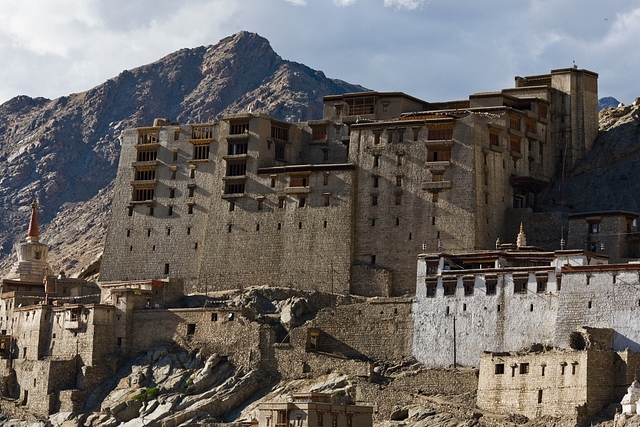
As Ladakh Seeks To Reclaim It’s Ancient Glory, A Look At Legendary Namgyal Kings Who Resisted Invaders
The cold desert nestled in the serene Himalayas, Ladakh is fast becoming hotspot for the Corporate Social Responsibility (CSR) investments of cash-rich Public Sector Units (PSU).
Not only is the government nudging the companies to do so, but also the rejuvenated district administration is playing an important role in hard-selling these projects to the companies, especially those who have business presence in the region.
An example is the Rs 50-lakh support by Hindustan Petroleum in the ‘Tsang-Da’ waste management project in Leh. On the other hand, Indian Oil is trying to make the city the ‘ice hockey capital’ of India, building up on the traditional passion among Ladakhis for archery. It is also looking forward to set up solar powered classrooms in the region.
The DC of the Leh district also said that AAI was installing what would be the country’s largest in any district hospital, mainframe MRI at the SNM hospital in Leh, along with other medical equipment at the hospital worth Rs 12 crore.
Now that its long-standing demand of separation from the Jammu and Kashmir has been met, the union territory of Ladakh is expecting frenetic development and a matching boom in tourism, along with protection of its ecology as well as the ‘Shangri La’ image.
In August, the Bharatiya Janata Party MP from Ladakh, Jamyang Tsering Namgyal became a social media sensation after his passionate speech in the Parliament went viral hailing the decision to separate Ladakh from Jammu and Kashmir whose government, he alleged, had neglected the region.
History
The name Ladakh literally translates to the ‘land of high passes’. It connected the rest of the India to the Silk Road. Ladakh used to be a vibrant trade centre in the region before China closed the age-old trade routes.
Before the Kushana empire extended itself into the region and Buddhism flourished in the 2nd century, the Ladakh region was practising the Bon religion. According to Rolf Alfred Stein, author of Tibetan Civilisation, the area of Shang Shung was not historically a part of Tibet and was a distinctly foreign territory to the Tibetans.
According to Stein, though its geographical extent remains a mystery, the Mount Kailasa and Lake Manasarovar formed part of this country. Stein says that the cult of visiting Kailasa might have started during this time.
“In fact, about 950, the Hindu King of Kabul had a statue of Viṣṇu, of the Kashmiri type (with three heads), which he claimed had been given him by the king of the Bhota (Tibetans) who, in turn had obtained it from Kailāśa,” he says.
In medieval times, Ladakh faced Muslim conquests like the rest of the subcontinent, and chose to seek and accept guidance in religious matters from Tibet. Many Ladakhis were converted to Islam during the period. The Muslim missionaries spread Islam and Baltistan region was almost entirely converted to Islam.
The Kingdom was weakened and divided until Bhagan, a Basgo king, reunited Ladakh. He took the title of ‘Namgyal’, meaning, ‘the victorious one’.
King Tashi Namgyal (1555-1575) managed to repel most Central Asian raiders, and built a royal fort on the top of the Namgyal Peak. Tsewang Namgyal temporarily extended his kingdom as far as Nepal.
Jamyang Namgyal, the son of Tsewang was defeated in a battle by the Balti king Ali Sher Khan Anchan. Khan attacked the capital city of Leh and destroyed Buddhist temples, monasteries, palaces, and burnt the records.
Later, Khan released Jamyang after he sought peace, on the condition that he married his daughter, and the next King of Ladakh would only be the son born to them.
The marriage was followed by influx of Muslim servants, artists and musicians in Ladakh. Private mosques were built for them to pray. Several Balti people also migrated to the kingdom and many Muslim traders were granted land to settle.
The successor Sengge Namgyal attempted to restore the old glory of Ladakh and built the Leh palace and several gompas. His son Deldan Namgyal was confronted by a zealous Aurangzeb whom he had to placate by building a mosque in Leh.
In the 19th century, Mughal rule was on the decline, and Sikh rule had been established in Punjab and Kashmir. The Dogra region was ruled by Rajputs at the time.
Raja Gulab Singh, a vassal of Sikh ruler Maharaja Ranjit Singh, invaded Ladakh in 1834 and dethroned the King Tshespal Namgyal. Ladakh was incorporated into the Dogra state of Jammu and Kashmir and the Namgyal family was given the jagir of Stok.